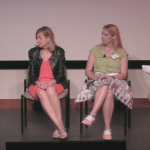Kakani Katija, C. Anela Choy, Rob E. Sherlock, Alana D. Sherman and Bruce H. Robison. Science Advances 16 Aug 2017: Vol. 3, no. 8
This link showed up in my email the other day (I subscribe to the “best of” articles as a daily post from Science). It looks pretty interesting, but I don’t know what “larvaceans” or “microplastics” are. I can probably guess what “microplastics” means–I’ve done some reading in my life, but what are larvaceans, and what do they have to do with such a story?
1. Read through the article, searching for terms and concepts I don’t understand. I look up these terms, usually by opening new tabs with the searches, both so I won’t lose my place in the original article, and to have several pages open for reference. (My friend and colleague at Stanford Sam Wineburg calls this method “lateral reading,” which emphasizes understanding the gestalt by pursuing multiple searches in parallel.
2. Simplify the text to a form that I understand. That is, I go sentence-by-sentence (or paragraph-by-paragraph) re-writing the article in language that I can comprehend.
“… solitary, free-swimming tunicates found throughout the world’s oceans. Like most tunicates, appendicularians are filter feeders.”
Plastic waste is a pervasive feature of marine environments, yet little is empirically known about the biological and physical processes that transport plastics through marine ecosystems. To address this need, we conducted in situ feeding studies of microplastic particles (10 to 600 μm in diameter) with the giant larvacean Bathochordaeus stygius. Larvaceans are abundant components of global zooplankton assemblages, regularly build mucus “houses” to filter particulate matter from the surrounding water, and later abandon these structures when clogged. By conducting in situ feeding experiments with remotely operated vehicles, we show that giant larvaceans are able to filter a range of microplastic particles from the water column, ingest, and then package microplastics into their fecal pellets. Microplastics also readily affix to their houses, which have been shown to sink quickly to the seafloor and deliver pulses of carbon to benthic ecosystems. Thus, giant larvaceans can contribute to the vertical flux of microplastics through the rapid sinking of fecal pellets and discarded houses. Larvaceans, and potentially other abundant pelagic filter feeders, may thus comprise a novel biological transport mechanism delivering microplastics from surface waters, through the water column, and to the seafloor. Our findings necessitate the development of tools and sampling methodologies to quantify concentrations and identify environmental microplastics throughout the water column.
Plastic waste is a pervasive feature of marine environments, yet little is empirically known about the biological and physical processes that transport plastics through marine ecosystems.
To address this need, we conducted in situ feeding studies of microplastic particles (10 to 600 μm in diameter) with the giant larvacean Bathochordaeus stygius.
Larvaceans are abundant components of global zooplankton assemblages, regularly build mucus “houses” to filter particulate matter from the surrounding water, and later abandon these structures when clogged.
By conducting in situ feeding experiments with remotely operated vehicles, we show that giant larvaceans are able to filter a range of microplastic particles from the water column, ingest, and then package microplastics into their fecal pellets.
Microplastics also readily affix to their houses, which have been shown to sink quickly to the seafloor and deliver pulses of carbon to benthic ecosystems. Thus, giant larvaceans can contribute to the vertical flux of microplastics through the rapid sinking of fecal pellets and discarded houses.
Larvaceans, and potentially other abundant pelagic filter feeders, may thus comprise a novel biological transport mechanism delivering microplastics from surface waters, through the water column, and to the seafloor.
Our findings necessitate the development of tools and sampling methodologies to quantify concentrations and identify environmental microplastics throughout the water column.
Plastic waste is a pervasive feature of marine environments everywhere in the ocean, yet little is empirically known about the biological and physical processes that transport plastics through marine ecosystems. and we don’t know much about how it moves around.
To address this need, we conducted in situ feeding studies of microplastic particles (10 to 600 μm in diameter) with the giant larvacean Bathochordaeus stygius. We fed some larvaceans tiny bits of plastic…
Larvaceans are abundant components of global zooplankton assemblages, regularly build mucus “houses” to filter particulate matter from the surrounding water, and later abandon these structures when clogged.
By conducting in situ feeding experiments with remotely operated vehicles, we show After we fed them, we saw that giant larvaceans are able to filter a range of microplastic particles from the water column, ingest, and then package microplastics into their fecal pellets. (Wow! They accumulate plastic and then poop it out.)
Microplastics also readily affix to their houses, which have been shown to sink quickly to the seafloor and deliver pulses of carbon to benthic ecosystems. Thus, giant larvaceans can contribute to the vertical flux of microplastics through the rapid sinking of fecal pellets and discarded houses. Larvacean poop and discarded “houses” carry microplastics to the bottom of the sea.
Larvaceans, and potentially other abundant pelagic filter feeders, may thus comprise a novel biological transport mechanism delivering microplastics from surface waters, through the water column, and to the seafloor.
Our findings necessitate the development of tools and sampling methodologies to quantify concentrations and identify environmental microplastics throughout the water column. (We need more study to figure out how big of an effect this is.)
Plastic waste is everywhere in the ocean, and we don’t know much about how it moves around.
We fed some larvaceans tiny bits of plastic and found that a lot of it ends up on the ocean floor.
When they feed, larvaceans build mucus “houses” to filter particulate matter from the water, and later abandon these structures when they get clogged up.
After we fed them, we saw that giant larvaceans are able to filter out microplastic particles from the water column. Surprise! They accumulate plastic and then poop it out.
Since microplastics are also on their external “houses,” this means that both Larvacean poop and discarded “houses” carry microplastics to the bottom of the sea.
We don’t think anyone else has noticed this.
We need more study and more tools to figure out how big of an effect this is.
 |
| Link to paper. |







